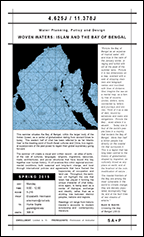Lecturer
(Visting Faculty Spring 2015)
 |
Biography Elizabeth Hermann is Professor of Landscape Architecture and teaches courses in Urban Design/Landscape Urbanism, Design and International Development, and Islamic Architectural and Urban History. She is the founder of the DESINE-lab @ RISD which brings design thinking, practices and outcomes together with innovation and entrepreneurship to address issues of global poverty and social and environmental injustice. Lab initiatives focus on three scales of collaboration and capacity building: Propel which develops programs with local leaders that use design thinking and processes to help create a climate for innovation and entrepreneurship in underserved communities; Alternative Livelihoods which, in collaboration with underserved communities, develops cooperative locally-driven economic strategies focusing on design and environmental stewardship; and Resilient City which strategizes how to aggregate and integrate these programs so as to address environmental degradation, natural disaster management, and persistent poverty at the scale of the city and region. Hermann received her Ph.D. from Harvard in the history of Islamic urbanism where her work focused on medieval Muslim cities, contagion theory, and designed responses to outbreaks of epidemic disease (Black Death) during prolonged periods of environmental and political upheaval. Hermann has been visiting faculty at Harvard’s Graduate School of Design and in the Aga Khan Program for Islamic Architecture at MIT. She was a SPURS Fellow in Urban Studies and Planning at MIT, and is a Fellow of the American Academy in Rome. Hermann has served as a senior advisor for master planning of the new Asian University for Women being built in Chittagong, Bangladesh, an outgrowth of the Task Force on Higher Education in Developing Countries (World Bank/UNESCO 2000). For the past decade she has worked in the megacities of South Asia on issues related to poverty alleviation, women’s rights and empowerment, education, resource management and environmental disasters, sustainable land-use practices within low-income inner-city neighborhoods, livelihood alternatives and enterprise development. She is co-founder of the Institute for Sustainable Urban Societies/ISUS, an international not-for-profit research, education, advocacy and design alliance located in Kolkata, Dhaka and Boston. Hermann is a contributing author to the Encyclopedia on Women in Muslim Cultures (EWIC) and author of the in-progress book Cities of Silt and Sand: Urbanization, Environment and Cultural Identity in the Bengal Delta and Cooperative Resilience: Community-Driven Development Strategies in South Asia. She is adjunct faculty at the Watson Institute for International Studies at Brown University and Social Innovator-in-Residence at the Social Innovation Lab at Babson College. |
Spring 2015 course
